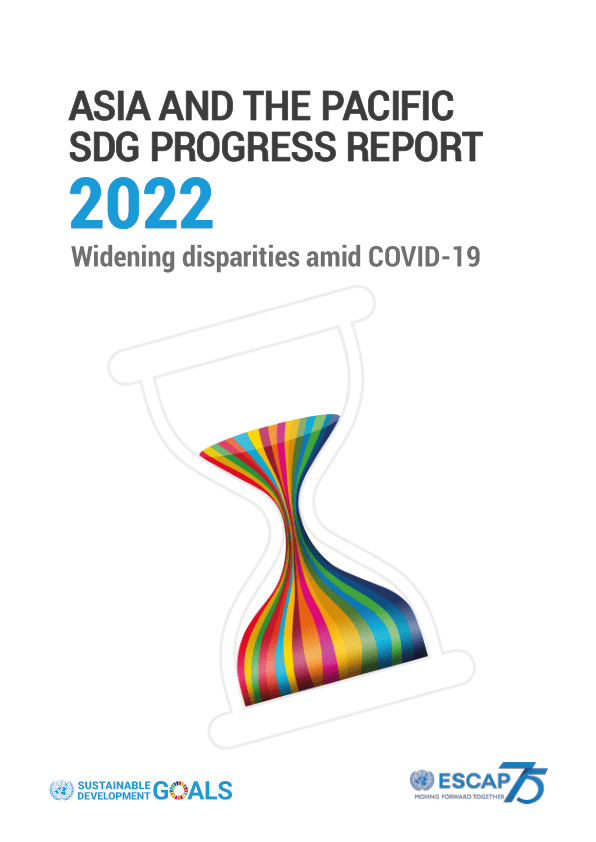EXECUTIVE SUMMARY
Throughout Asia and the Pacific, Governments are striving towards the Sustainable Development Goals (SDGs) and the ambitious objectives of reaching the furthest behind first, but the progress is insufficient and has in fact, decelerated. The challenge of achieving the goals has been magnified in recent years by an increase in the frequency and intensity of humanmade crises and natural disasters, as well as the challenges of responding to the coronavirus disease (COVID-19) pandemic. In this context, the Asia-Pacific Sustainable Development Goal Progress Report 2022 provides an analysis of progress on 17 SDGs and 169 targets in the region and in each of the five subregions where there are unique challenges, resources and opportunities for progress. The report also provides an analysis of data gaps that prevent the monitoring of progress, and it provides an investigation of sources and priority areas for enhancing SDG data availability.
Progress towards the SDGs in the Asia-Pacific region has slowed as the COVID-19 pandemic and climate change have exacerbated development challenges. The region is not on track to achieve any of the 17 SDGs.
The vision and ambition of the 2030 Agenda for Sustainable Development are no less critical and relevant than they were in 2015, yet the expected year for the achievement of the SDGs is now 2065, and the gap grows wider with each passing year. The Asia-Pacific region is now facing the economic impact of the crisis and the risk that progress will slow down even more in the coming years as environmental and social targets are compromised. That outcome can be avoided if the region steps up and embraces the SDGs as a road map for an inclusive, equitable and just recovery.
The inequity of progress towards the SDGs is evidenced in the lives of vulnerable population groups throughout Asia and the Pacific who are most at risk of being left behind. Slow progress, stagnation and regression against the SDG targets continue to place the greatest burden on those who are furthest behind.
While there has been significant progress in the region on industry, innovation and infrastructure (Goal 9) and affordable and clean energy (Goal 7), the pace has been too slow to reach the goals by 2030. Regression on responsible consumption and production (Goal 12) and climate action (Goal 13) has occurred even as the climate crisis has become more acute. Meanwhile, progress across Goals 4, 5, 6, 8, 11 and 14 throughout Asia and the Pacific has been very slow or even stagnant.
At the current rate of change, none of the 17 SDGs will be achieved in all five subregions, and only East and North-East Asia is on track towards no poverty (Goal 1) and industry, innovation and infrastructure (Goal 9).
There is an urgent need for regional collaboration and partnerships to ensure that no one and no country in any of the Asia-Pacific subregions is left behind as SDG progress stagnates or regresses. Apart from Goal 1 and Goal 9 in East and North-East Asia, the Asia-Pacific subregions are not on track to achieve the SDGs by 2030. Alarmingly, every Asia-Pacific subregion has regressed on responsible consumption and production (Goal 12) and climate action (Goal 13).
In addition to regression on Goal 12 and Goal 13, the North and Central Asia subregion has regressed on life below water (Goal 14); the Pacific subregion has regressed on clean water and sanitation (Goal 6), reduced inequalities (Goal 10) and sustainable cities and communities (Goal 11); the South-East Asia subregion has regressed on Goal 6, Goal 11 and Goal 14; and the South and South-West Asia subregion has regressed on Goal 11.
Leaving no one behind, regardless of age, gender, race, ethnicity, location, disability or migratory status, remains the central commitment of the 2030 Agenda, and the need to reach those who are furthest behind has never been greater.
Average progress in Asia and the Pacific disproportionately excludes some groups with distinct demographic or socioeconomic characteristics. Those furthest behind, including women, rural populations and poorer households, generally face more vulnerabilities.
For many vulnerable populations, food security, education and livelihoods have deteriorated during the pandemic.
One third of the global population of child refugees live in the Asia-Pacific region, and the pandemic has added to the challenges they face. The intersection of poverty and climate change often impacts the livelihoods of women, who account for the majority of agriculture sector workers in some areas.
The analysis in this report shows that more must be done to expand social protection for vulnerable populations, including persons with severe disabilities, and to improve the labour market prospects of people with disabilities.
While data availability has improved since 2017 (the number of indicators with data has doubled), 57 out of 169 targets (34 per cent) still can not be measured. Data availability on gender equality (Goal 5), life below water (Goal 14) and peace, justice and strong institutions (Goal 16) remains somewhat limited.
Cooperation between national and international custodian agencies for SDG indicators have significantly contributed to SDG data availability and must continue to close the remaining gaps in the data. More investment and technical cooperation are needed to ensure timeliness and sustainability in conducting household surveys as the main source for nearly one third of the SDG indicators. Enhanced national coordination and data sharing and integration must be prioritized to harness the full potential of administrative data (including civil registration and vital statistics) for the SDGs.


